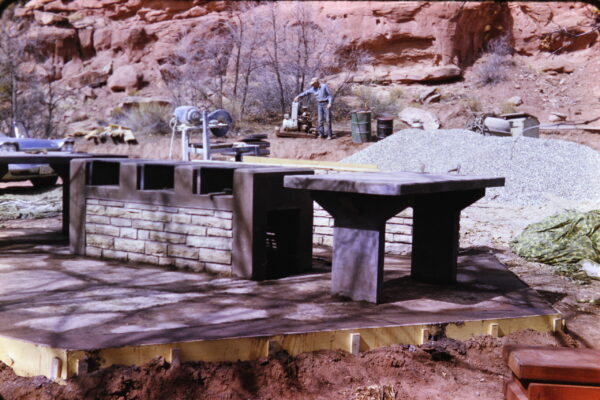The 30-day public comment period for the Calf Creek Recreation Area ended on November 26, 2022. Disappointment but not surprise would describe my review of the Environmental Assessment (EA). I consider myself an advocate of the cultural values that exist in our county that is made up of 96.7% federal or state lands. As a federal employee I understand the process of public input. As a private citizen, I have been working to maintain cultural values and get communities involved in that process in their large government backyard.
Site #12
When the Bureau of Land Management (BLM) first proposed the Calf Creek project in 2017, my comments primarily focused on cultural values. The BLM Land Management Plan required preserving those values, but the project seemed to ignore them. Their actions included adding parking and campsites while taking away historic group areas and removing or limiting family use. An example of one such comment involved the removal of site #12, one of the few sites that can accommodate large tent or family camping, and replacing it with three walk-in sites.
A Danger Ignored
On two separate occasions I had observed evidence of flooding with a high-water mark of 12 and then 8 inches in the walk-in area. Response to my 2017 comment was a dismissal including a statement that sites would be four feet above base flow (an indication to me that they didn’t believe me), that flooding is “relatively infrequent,” and that signs would be placed in these new sites warning of the risk. They further stated, “campers must use reasonable judgment and evaluate their risk tolerance in deciding where they camp.”
In my appeal to their decision and response to ignoring my comment I stated, “The idea that the GSENM would put the lives of the visitors at risk at a designated campsite, the nature of the designation implying safety is reprehensible.” I also pointed out that the BLM’s argument that visitors could flee to safety was flawed on many counts including the inability to flee a flood in the middle of the night.
I stated the action would result in significant effects to public health and safety. I highlight this comment because in 2021 the BLM scoped an almost identical proposal that included once again, the removal of site #12 next to the suspension bridge in an effort to add camping sites.
Was the Dismissed Comment Heeded Afterall?
After scoping, public comments are reviewed for substance. Issues identified must be analyzed with a new alternative or documented how they are addressed and/or dismissed. The Environmental Assessment, pgs. 65-66 include public comments and how they were considered but dismissed from further analysis.
You will see on p. 65 that my comment regarding site #12 resulted in removing the proposed walk-in sites from analysis because it did not meet the purpose and need of improving health and safety. So why, after my previous comments and appeal on that issue, and the inclusion once again in the scoping, was it finally removed? Was it because they finally decided to take me seriously? Or maybe the hydrologist pointing out the highway drainage culvert above the proposed site during an interdisciplinary field trip caused the removal of the safety issue.
Among others, my comments have included: protesting the refusal to acknowledge that a group camp site has always existed adjacent to the day-use area, asking for the retention of the historic group picnic area with the long wooden tables capable of letting families and friends sit together along with the historic grill and preparation area, the need to retain and designate the group site instead of constructing an amphitheater which is not needed but I suspect is wanted for arts festival activities, disagreement with project timing of why the BLM can’t implement during the slow visitor use periods, the request of data that vault toilets replacing flushing toilets will be capable of supporting the current use concurrently with their ability to empty them, and questioning the lack of coordination with and providing adequate emergency access to our volunteer search and rescue.
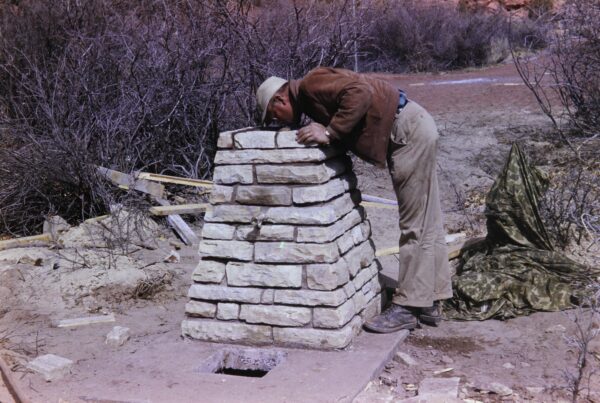
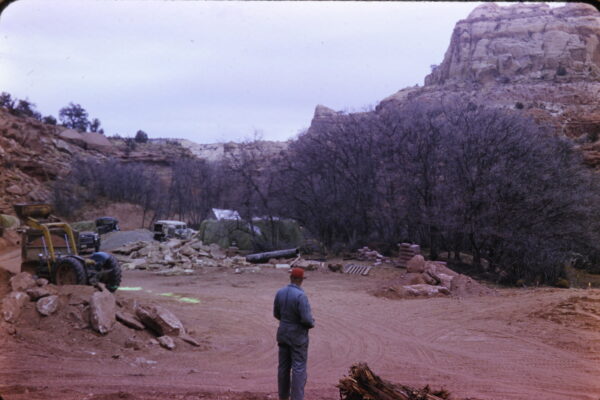
Increased Parking, but Limited Use, at the Calf Creek Lower Falls
One item of note is the shift in stance between previous documents and the recently published EA. While the BLM admits that visitor use in the area is increasing, the EA states that including the trail in their analysis would be done at a more appropriate time when a new management plan is completed.
This includes looking at carrying capacity concerns like human and pet waste issues along the trail, and emergency access by our volunteers. The BLM had to post a health warning this past summer for the Calf Creek Lower Falls, restricting swimming in the water. The EA tries to convince the public that increasing parking by 70 spaces, (15 to current area, 40 in a new site, and 15 along the road) would not increase use at the area or up the trail. The BLM believes this rationale provides the excuse not to analyze the project’s effects on the trail system or vice versa.
Ignoring the issues on the trail system blatantly violates their own regulations that require them to look at indirect and cumulative effects of their actions. Certainly the old adage of “If you build it, they will come” applies to this increase in parking. But the EA doesn’t acknowledge any of that because that would require them to address the real health and safety issues.
To prove this point further, look at the issue from the opposite view. What if the future analysis of the trail shows that a lottery system should be used? You would have 70 extra parking spaces, public funds spent, and an ugly mess because they refused to consider the entire system.
Emergency Responder Involvement
Another comment I presented was questioning the lack of emergency responder involvement during the development of a new trailhead and trail.
I will pose the scenario to the reader.
If the current trail system has an emergency extraction issue that interferes with patients getting urgent medical care in a timely manner, is it logical for the BLM to involve emergency responders in the development of this proposal? I would argue that it is not only logical, but the BLM has an ethical and moral obligation, especially with a portion of the Calf Creek project’s purpose and need is public health and safety.
But how were requests by emergency responders considered? Well, one request for use of utility terrain vehicles for patient extraction was dismissed because those activities would be in a Wilderness Study Area (WSA) and somehow, the use is not temporary and creates surface disturbance on an existing trail. However, if you go to the BLM’s own website, only portions of the new trail are within the designated WSA. Isn’t this contradictory? Why would these groups not be included and what real reason does the BLM have for not looking at the trail system as a whole? Is transparency, another requirement of proposed projects, too much to ask?
Another item that brings into question the true intentions of the project is the placement of the trail along the cliff above the current campsites. Most of you would guess that it will be a common occurrence for someone to chuck a rock off and over the edge into the campsites below.
A Disregard for Locals
I provide the following photos of the construction of the Calf Creek area that has hosted so many cultural activities and has provided enjoyment to the community. But local use has unfortunately decreased as structures are removed, group use areas are ignored or are proposed for removal, and increased visitor use is not addressed. Another purpose and need listed in the EA is to enhance visitor experience. Is having health warnings, human and pet waste issues, and supplying that much parking for that many people enhancing the experience of visitors?
Is there overwhelming support for the project that real health and safety issues continue to be ignored and discounted? Does the community that has used the area for so long feel that their values are being considered when group use is neglected, ignored, and proposed for removal? The public site visit should have been provided upfront instead of the public having to demand that it be held. The fact that three law enforcement officers were present is an indicator that this project is not widely supported.
I have submitted five separate comments as a private citizen on this project since its development. All have been largely ignored, dismissed, misrepresented, misconstrued and have inappropriately affected my professional life. However, I believe in supporting the cultural values and the communities that support me and my family.
Calf Creek’s Historical Significance Lost
Historically, much thought and effort by Delmar Price went into the development of the recreation area so that it fit on the landscape and provided quality human experiences. The attributes Price instilled at the site are being threatened. Construction photos show how much effort he spent designing the human experience into the landscape including preserving 150+-year-old oaks.
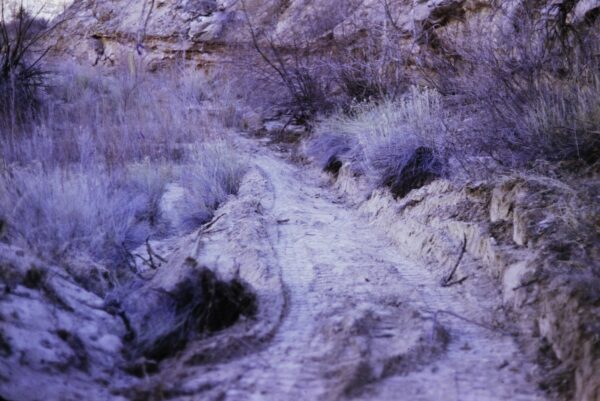
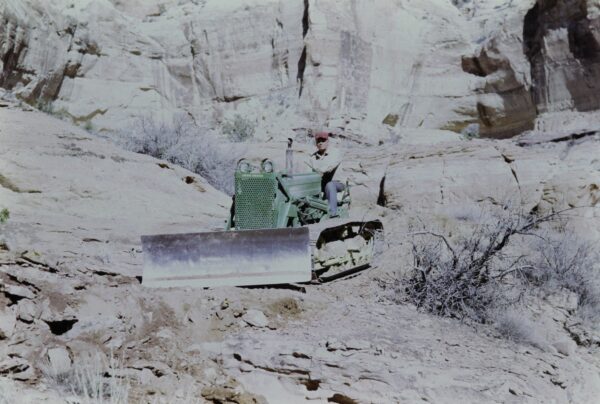
Under this proposal, much of this will be lost.
Just because you think you can do something doesn’t mean you should. Citizens should be consulted and truly involved in these projects instead of being ignored. Maybe if that was common practice, the BLM wouldn’t have graveled over the old wagon wheel marks at Dance Hall Rock. Emergency responders, please note the photos of the trail being built by a small dozer!
According to the website, the Public Affairs Specialist for the BLM is David Hercher, 435-899-0415, dhercher@blm.gov.
– by Lisa Young
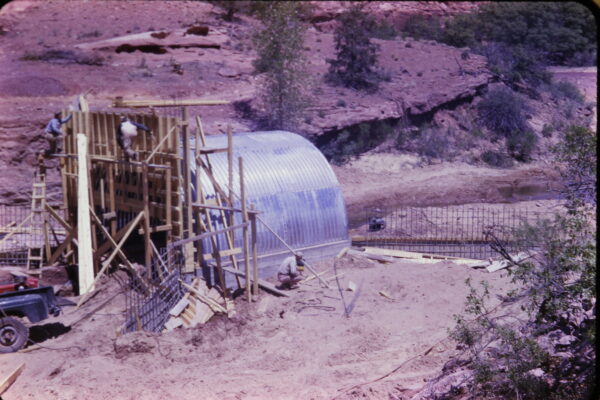
Feature image caption: The old picnic tables at Calf Creek.

